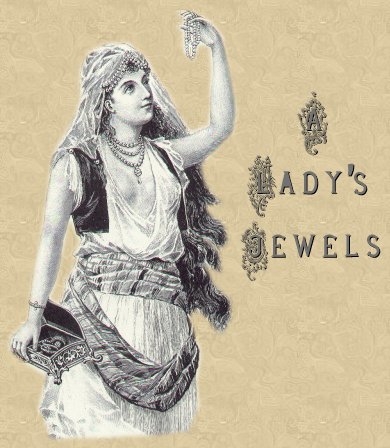

| Victorians saw symbolism in everything from flowers to fans, and
used it to express affection, protect loved ones, even ward off evil. They saw the world
as romantic and a little magical. And they enjoyed a little mystery, delighting in secret
gardens and hidden compartments. All of these characteristics came
into play in their jewelry, of which they were also fond. Rings and brooches especially,
were used to convey sweet messages and sentiments of adoration, and in true Victorian
fashion, often secretly. Regard jewelry, also known as message jewelry, is a classic example. A friend or loved one might give a brooch or ring with six gemstones in a row -- ruby, emerald, garnet, amethyst, ruby and diamond, the first initial of each gem spelling out "regard." The messages also might be "dearest," (diamond, emerald, amethyst, ruby, amethyst, sapphire, topaz) or "dear" (diamond, emerald, amethyst, ruby) or the name of the wearer. Most message jewelry dates between 1830 and 1900; coincidentally (or not?) , Victoria reigned from 1837 to 1901. Some other symbols are often seen in Victorian jewlery design. Clasped hands denoted friendship; a hand holding a wreath stood for mourning. A snake represented eternity and/or eternal love, especially when depicted as a circle with its head in its mouth. The motif of a cross, anchor and heart, symbolizing faith, hope and charity, respectively, was also frequently seen on brooches and rings of the age. Mourning jewelry was also popular during the period. Hair of the deceased was woven into rings, bracelets, and necklaces, or snipped and carried in secret compartments in lockets. Lilies of the valley and forget-me-nots were often used in mourning jewelry to represent remembrance. Gems through the ages have been imbued by many cultures with magic powers. The Victorians were no exception. They not only subscribed to that idea, they also assigned meanings to various stones. Rubies meant passion, emeralds fidelity. Pearls stood in for tears. Garnets were thought to empower and to protect against lightning. Bloodstone was reputed to preserve health. Coral was believed to fight off disease and evil spirits. Women wore carved coral as cameos and beads, and little pieces of branch coral wound with gold wire as brooches. They protected their children with it. Coral objects were favored christening gifts. Rings and brooches bearing the ancient Hebrew word "mizpah" were another form of protection. Originally meaning "watchtower," it came to symbolize a talisman for loved ones far away, perhaps at war. The items generally were engraved with a biblical reference (Genesis 31:49): "The Lord watch between me and thee when we are absent one from another." |

Disclaimer: Granny's Closet provides the information contained in this website for information and entertainment purposes only and neither endorses, claims expertise/experience, or takes responsibility for the use of any of the information found herein.